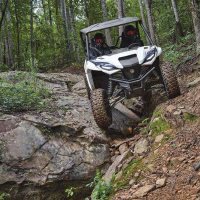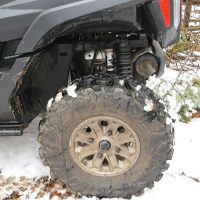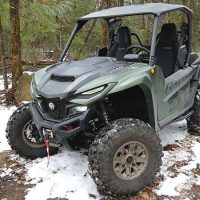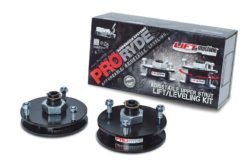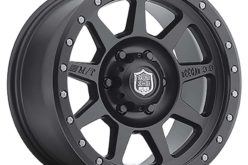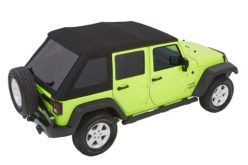
This new RMAX model isn’t just a revised Wolverine X2 either, as it receives its own unique frame, engine, interior and suspension. Pumping out 108 horsepower is a brand new 999cc liquid-cooled 4-stroke parallel twin-cylinder engine, a nice boost in output compared to the 69 ponies coming from the brand’s 850 powerplant. That 850 was also known for being exceptionally smooth and quiet, and while the former is true of this new 999cc unit, the latter isn’t quite true. But that’s a good thing. This RMAX has a raucous exhaust note and pronounces itself when you step on it, giving it a little of the hooligan DNA it needed to become a trail-eating monster.
Maybe more important than the power increase, though, is the way the Wolverine RMAX manages that power with its new D-mode drive selector. Three settings are available (Trail, Sport & Rock Crawl) and each is quite different. In Trail mode, the throttle is set up for good power delivery, but doesn’t make it so sensitive that you end up stabbing it over rough terrain. Turn it to Sport and you get maximum throttle response and power at all times, while Rock Crawl mode does the opposite, taking away all throttle response and increasing engine braking to make sure you can be ultra smooth over rough obstacles. You can also choose to run the RMAX in two-wheel drive, four-wheel drive or diff lock, the latter of which will lock up the front differential.

The model we tested was the Wolverine RMAX2 EPS SE, arriving with FOX QS3 piggyback shocks offering 14.2-inches of travel in the front and 16.9-inches in the rear. This allows you to take rough trails with serious speed, and makes the RMAX a serious adventure machine capable of keeping its occupants isolated well from the trail below. This machine isn’t quite to the level of the whoop-eating sport-focused side-by-sides like the RZR Pro XP and Kawasaki KRX, but it’s not far behind.
As the name suggests, the QS3 shocks offer three different selectable settings for firmness, though an upgraded set of active shocks is available that can be controlled from inside the RMAX. And just in case the suspension and tires reach the end of their rope, a Warn winch comes standard on the SE package.
Fresh styling on the RMAX is hard to ignore as well, looking even angrier than it did before, something of a prerequisite in side-by-side design these days. The addition of two LED lights above the functional headlights gives the RMAX great presence and a unique signature.

A digital gauge cluster delivers all of your important information, and it tilts with the steering wheel, a handy feature for keeping the screen at the right angle for your eyes. Storage abounds inside with a centre console bin, glove box and small cubby in the centre stack. Small details also make a big difference inside this RMAX, such as the quality of the latches. The glove box uses a push-button opening mechanism, the doors have been made thicker and more solid and even the centre console latch feels automotive grade. There is even lighting in the cupholder, the storage area and in the footwells, much like what you find in a car or truck.
Adventuring is now well-handled by the RMAX, but the reason you buy this model is its capability to also work, and that’s where the dump bed comes in. Two handles, one on each side of the machine, operate the dumping capability, and this bed is rated to handle up to 600 pounds of cargo. A heavy-duty D-ring is ready in each corner of the bed if you need to tie something down, and just like a pickup truck bed, grooves are made in the bed walls to accommodate wooden dividers. Plus, a two-inch hitch receiver is installed below, capable of towing up to 2,000 pounds.
Pricing in Canada starts at $24,299, while the SE model that we tested comes with a price tag of $26,799. There is a four-seat RMAX model available as well and it tops out the price charts, selling for $29,299.
Finding the limits of the Yamaha Wolverine X2 850 wasn’t all that challenging, and while that machine is fun to ride, the excitement factor can get old pretty quick. Add in a nice helping of ponies and plenty of suspension travel, and we’re left with the RMAX, a serious contender for being one of the most fun machines on the market that can still haul.





